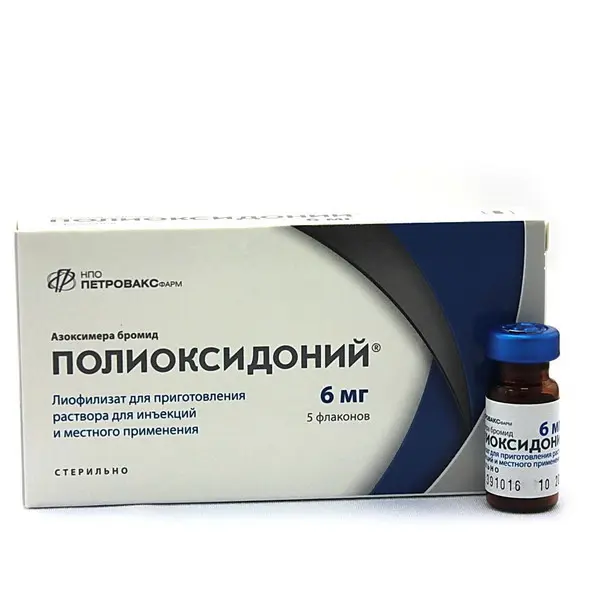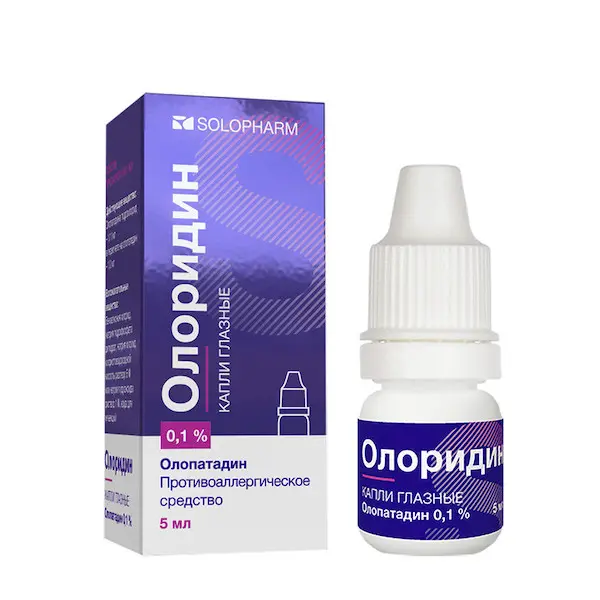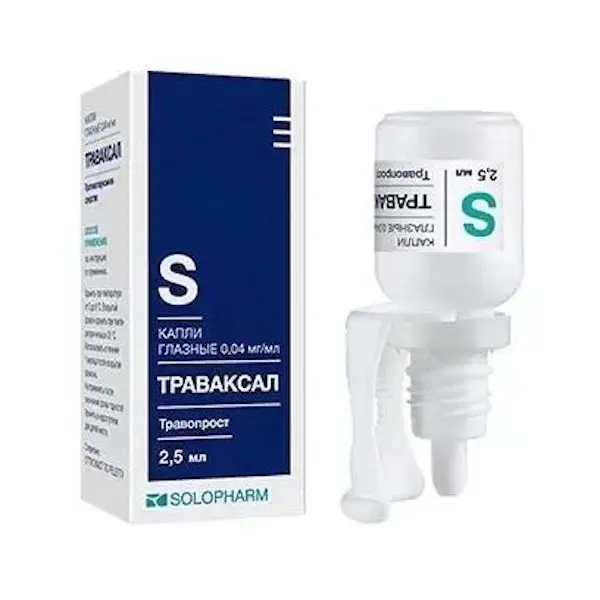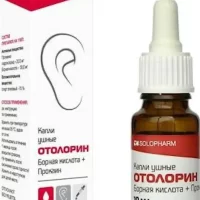Description
Polyoxidonium Pharmacodynamics
Azoximera bromide has a complex action: immunomodulatory, detoxifying, antioxidant, moderate anti-inflammatory.
The basis of the mechanism of immunomodulatory action of Azoximer bromide is a direct impact on phagocytic cells and natural killer cells, as well as stimulation of antibody formation, synthesis of interferon-alpha and interferon-gamma.
The detoxifying and antioxidant properties of Azoximer bromide are largely determined by the structure and high molecular weight nature of the drug. Azoximera bromide increases the body’s resistance to local and generalized infections of bacterial, fungal and viral etiology. Restores immunity in secondary immunodeficiency conditions caused by various infections, injuries, complications after surgery, burns, autoimmune diseases, malignant tumors, chemotherapy drugs, cytostatics, steroid hormones. The use of Polioxidonium® against secondary immunodeficiency states can improve and shorten the duration of treatment, significantly reduce the use of antibiotics, bronchodilators, glucocorticosteroids and extend the period of remission.
Inclusion of Polioxidonium® in the treatment of cancer patients reduces intoxication during chemotherapy and radiation therapy and in most cases allows the standard therapy without changing the regimen due to the development of infectious complications and side effects (myelosuppression, vomiting, diarrhea, cystitis, colitis and others).
A characteristic feature of Azoximer bromide when used topically (intranasally, sublingually) is the ability to activate the body’s early defense factors against infection: the drug
stimulates bactericidal properties of neutrophils, macrophages, enhances their ability to absorb bacteria, increases the bactericidal properties of saliva and mucosal secretion of the upper respiratory tract.
Azoximera bromide blocks soluble toxic substances and microparticles, has the ability to remove from the body toxins, salts of heavy metals, inhibits lipid peroxidation by both intercepting free radicals and through the elimination of catalytically active Fe2+ ions. Azoximera bromide reduces the inflammatory response by normalizing the synthesis of pro- and anti-inflammatory cytokines.
Azoximera bromide is well tolerated, has no mitogenic, polyclonal activity, antigenic properties, has no allergic, mutagenic, embryotoxic, teratogenic and carcinogenic effect. Azoximera bromide
is odorless and tasteless, has no local irritant effect when applied to the mucous membranes of the nose and oropharynx.
Indications
It is used in adults and children from 6 months for treatment and prophylaxis of infectious and inflammatory diseases (of viral, bacterial and fungal etiology), with acute and remission phases.
For the treatment of adults (in combination therapy):
– Chronic recurrent inflammatory and infectious diseases of various localizations, bacterial, viral and fungal etiology in acute remission stage;
– Acute viral, bacterial infections of ENT-organs, upper and lower respiratory tract, gynecological and urological diseases;
– acute and chronic allergic diseases (including pollinosis, bronchial asthma, atopic dermatitis), complicated by bacterial, viral and fungal infections;
– malignant tumors during and after chemotherapy and radiation therapy to reduce the immunosuppressive, nephro- and hepatotoxic effects of drugs;
– generalized forms of surgical infections; for activation of regenerative processes (fractures, burns, trophic ulcers);
– rheumatoid arthritis, complicated by bacterial, viral and fungal infections, against the background of long-term immunosuppressants;
– pulmonary tuberculosis.
For the treatment of children over 6 months (in the complex therapy):
– Acute and exacerbation of chronic inflammatory diseases of any localization (including ENT-organs – sinusitis, rhinitis, adenoiditis, pharyngeal tonsil hypertrophy, ARVI), caused by pathogens of bacterial, viral, fungal infections;
– acute allergic and toxic-allergic conditions complicated by bacterial, viral and fungal infections;
– Bronchial asthma complicated by chronic respiratory tract infections;
– Atopic dermatitis complicated by purulent infection;
– intestinal dysbacteriosis (in combination with specific therapy).
For the prevention (monotherapy) in children over 6 months and adults:
– Influenza and acute respiratory infections;
– postoperative infectious complications.
Contraindications
– Individual hypersensitivity;
– Pregnancy, breast-feeding;
– Children under 6 months of age;
– acute renal failure.
Dosage and administration
- Methods of administration of the drug Polioxidonium®: parenteral (intramuscular, intravenous), intranasal, sublingual.
- Regimen of administration, dosing, necessity and frequency of subsequent courses of therapy shall be chosen by a physician, depending on the severity of the disease and age of the patient.
- For intravenous drop administration a dose of the drug calculated for a patient is sterilely transferred from the syringe into a vial/packet with 0.9% sodium chloride solution. Prepared injections shall not be stored.
- Recommended treatment regimens for adults:
- Parenterally (intramuscularly or intravenously): the drug is administered to adults in doses of 6-12 mg 1 time per day daily, every other day, or 1-2 times per week depending on the diagnosis and severity of the disease.
- In acute viral and bacterial infections of ENT organs, upper and lower respiratory tracts, gynecological and urological diseases: 6 mg daily for 3 days and then every other day for a total of 10 injections.
- In chronic recurrent infectious-inflammatory diseases of various localizations, bacterial, viral and fungal etiology, in the acute stage: 6 mg every other day for 5 injections, then 2 times a week for a total of 10 injections.
- In acute and chronic allergic diseases (including pollinosis, bronchial asthma, atopic dermatitis) complicated by bacterial, viral and fungal infections: 6-12 mg, 5 injections a day.
- In rheumatoid arthritis complicated by bacterial, viral and fungal infection combined with prolonged immunosuppressant therapy: 6 mg, 5 injections daily, 2 times a week for a total of 10 injections.
- In generalized forms of surgical infections: 6 mg daily for 3 days and then every other day for a total of 10 injections.
- For activation of regenerative processes (fractures, burns, trophic ulcers): 6 mg for 3 days and then every other day for a total of 10 injections.
- For prevention of postoperative infectious complications: 6 mg every other day for 5 injections.
- In pulmonary tuberculosis: 6 mg 2 times a week for a course of 20 injections.
- In cancer patients:
- – Before and during chemotherapy to reduce the immunosuppressive, hepato- and nephrotoxic effects of chemotherapeutic agents: 6 mg every other day with a course of
- 10 injections; further frequency of administration is determined by a physician depending on tolerance and duration of chemotherapy and radiotherapy;
- – for prevention of the immunosuppressive effect of the tumor, for correction of immunodeficiency after chemotherapy and radiation therapy, after surgical removal of the tumor, long-term use of Polioxidonium® (from 2-3 months to one year) 6 mg 1-2 times a week is indicated. When prescribing a long course, no cumulation effect, manifestation of toxicity and habituation are observed.
- Intranasally or sublingually (see section “Administration guidelines for sublingual and intranasal administration”):
- – For treatment of acute and exacerbations of chronic ENT-organ infections;
- – For the treatment and prevention of influenza and acute respiratory infections;
- – To enhance regenerative processes of mucous membranes;
- – For the prevention of complications and relapses of chronic diseases.
- The total volume of the drug per day is 1 ml (20 drops) – 6 mg/ml syringe.
- Daily dose of the drug is administered intranasally or sublingually in 3-4 doses per day.
- Recommended treatment regimens in children:
- Parenterally (intramuscularly or intravenously): administered to children from 6 months of age in a dose of 0.1-0.15 mg/kg daily, every other day or 2 times a week for a course of 5-10 injections.
- In acute and acute exacerbations of chronic inflammatory diseases of any localization (including ENT organs – sinusitis, rhinitis, adenoiditis, pharyngeal tonsil hypertrophy, acute respiratory viral infections) caused by bacterial, viral, fungal infections: 0.1 mg/kg for 3 consecutive days, then daily for a total of 10 injections.
- In acute allergic and toxic-allergic conditions (including bronchial asthma, atopic dermatitis) complicated by bacterial, viral and fungal infections: 0.1 mg/kg for 3 days daily and then every other day for a total of 10 injections in combination with basic therapy.
- Intranasally or sublingually (see section “Administration rules for sublingual and intranasal administration”):
- – In acute and chronic rhinitis, rhinosinusitis, adenoiditis (treatment and prevention of exacerbations);
- – For preoperative preparation of patients during surgical interventions for ENT diseases, as well as in the postoperative period in order to prevent infectious complications or relapses;
- – Treatment and prevention of influenza and other acute respiratory infections (within 1 month before the anticipated epidemic), at any time after the onset of the disease and in the period of recuperation).
- – For the treatment of intestinal dysbacteriosis (used sublingually) in combination with basic therapy – for 10 days.





